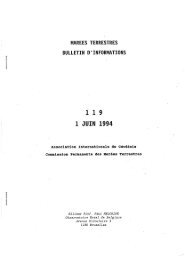marees terrestres bulletin d'informations - Université de la Polynésie ...
marees terrestres bulletin d'informations - Université de la Polynésie ...
marees terrestres bulletin d'informations - Université de la Polynésie ...
You also want an ePaper? Increase the reach of your titles
YUMPU automatically turns print PDFs into web optimized ePapers that Google loves.
1994), and TPXO.6 (Egbert et al., 1994). Consequently the accuracy of estimation of loading<br />
effect has been remarkably improved (e.g. Bos et al., 2002, Sato et al., 2004, Neumeyer et al.,<br />
2005 for the gravity, and Thomas et al., 2007 for the Global Positioning System (GPS)<br />
observation).<br />
However, in contrast to the open seas, accuracy of the global ocean ti<strong>de</strong> mo<strong>de</strong>ls is still<br />
questionable in the coastal regions. For example, Southeastern A<strong>la</strong>ska (SE-AK) is one of the<br />
p<strong>la</strong>ces which show <strong>la</strong>rge discrepancy between the observations and the mo<strong>de</strong>ls. The total tidal<br />
range at Juneau exceeds 8 m (NOAA website, http://ti<strong>de</strong>sandcurrents.noaa.gov/in<strong>de</strong>x.shtml), for<br />
instance. The analysis results for the 3-years ti<strong>de</strong> gauge data at Juneau indicate that the observed<br />
amplitu<strong>de</strong> and phase of M 2 ti<strong>de</strong> are 198.612+/-0.064 cm and 282.736+/-0.018 <strong>de</strong>grees,<br />
respectively. On the other hand, those of the five global ocean ti<strong>de</strong> mo<strong>de</strong>ls mentioned above are<br />
133 cm to 353 cm in the amplitu<strong>de</strong> and 206.9 <strong>de</strong>g to 277.0 <strong>de</strong>g in the phase at the grid close to<br />
Juneau. The differences in the proposed global mo<strong>de</strong>ls are consi<strong>de</strong>red to be mainly due to the<br />
complex bathymetry and coastline in SE-AK, which are not well represented with the grid size<br />
of these global mo<strong>de</strong>ls.<br />
2. Southeast A<strong>la</strong>ska (SE-AK)<br />
From the point of view of the geo<strong>de</strong>sy and geophysics, SE-AK is an interest p<strong>la</strong>ce, because<br />
very rapid uplift rates exceeding 30 mm/yr at maximum are observed there, which are mainly<br />
caused by g<strong>la</strong>cial isostatic adjustment (GIA), including the effects of past and present-day ice<br />
melting. During ‘Little Ice Age’ (LIA), this area was completely covered with g<strong>la</strong>ciers of up to<br />
1.5 km in thickness. Since the middle of the 19th century (i.e. about 250 years ago), when LIA<br />
began to wane, this thick ice coverage has rapidly retreated (e.g. Molina, 2008). Therefore, it is<br />
consi<strong>de</strong>red that, for the effect of the past ice, the melting of the ice of LIA mainly contributes to<br />
the observed uplift rates (Larsen et al., 2005 and Larsen et al., 2007).<br />
A joint Japanese-American observation project called ISEA (International geo<strong>de</strong>tic project<br />
SouthEastern A<strong>la</strong>ska) was initiated in 2005 to follow up the work of the University of A<strong>la</strong>ska<br />
Fairbanks (UAF) by adding new geo<strong>de</strong>tic data sets (Miura et al., 2007). In this project, three<br />
kinds of geo<strong>de</strong>tic measurements are carried out to study GIA, loading <strong>de</strong>formation and tidal<br />
variations in and around G<strong>la</strong>cier Bay in SE-AK: (1) the absolute gravity (AG) and re<strong>la</strong>tive<br />
gravity surveys, (2) surveys with GPS and the establishment of new continuous GPS sites and<br />
(3) gravity ti<strong>de</strong> observations. For the GPS, EarthScope (http://earthscope.org) continuous GPS<br />
data are also used in this project.<br />
In the SE-AK region, the ti<strong>de</strong>s including the OTL effects are the major signal in the observed<br />
gravity and disp<strong>la</strong>cement signals over periods less than seasonal. The OTL effect is 15-30 times<br />
<strong>la</strong>rger than the nominal precision of the absolute gravity measurements (i.e. 1-2 Gal).<br />
11752



